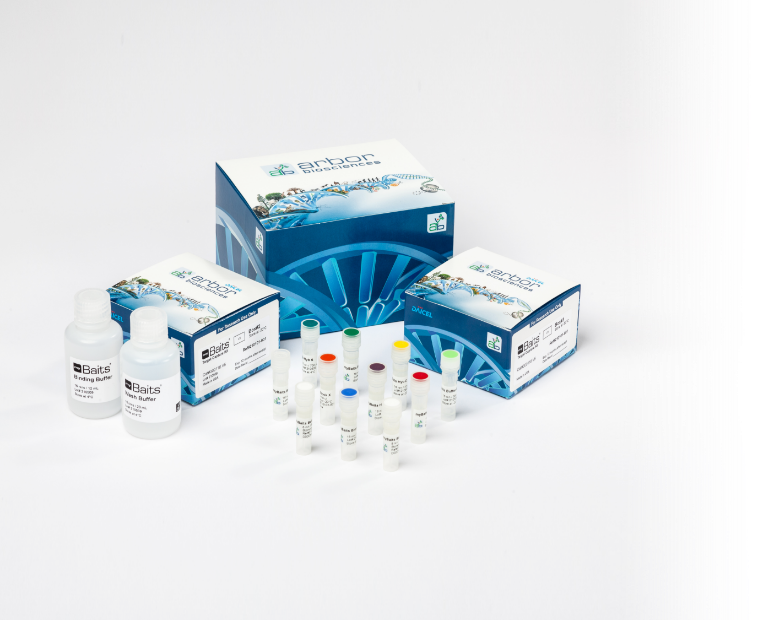Overview
Over the last decade, myBaits® Custom kits have been applied to NGS research for virtually all model and non-model animal phyla including arthropods, chordates, cnidaria, echinoderms, molluscs, and more. Vertebrate research has been heavily represented for both extant and extinct taxa, including tetrapods and Chrondrichtyhes and Osteichthyes fishes.
Daicel Arbor is your source for myBaits Custom panels designed by researchers and available to support your animal research.
Have a suggestion for a new panel to add to our list? Contact us today.
FrogCap - Ranoidea V1
Enrichment panel designed for Ranoidea frog phylogenetics that includes exon markers plus legacy and UCE markers for a total of >13.5K markers targeting >3.4 Mbp. Exon marker sequences derive from the Nanorana parkeri reference genome. Hutter et al. (2021) evaluated the panel and demonstrated its effectiveness on a range of samples within the Ranoidea superfamily. More info at frogcap.org
Reference: Hutter, C.R., K.A. Cobb, D.M. Portik, S.L. Travers, P.L. Wood, R.M. Brown. (2022). FrogCap: A modular sequence capture probe-set for phylogenomics and population genetics for all frogs, assessed across multiple phylogenetic scales. Molecular Ecology Resources, 22: 1100–1119.
Design ID: D10259HFrog
FrogCap - Ranoidea V2
Enrichment panel designed for Ranoidea frog phylogenetics that is a revised version of the Ranoidea
V1 panel described above; the final design targets >3.3 Mb and includes >10.7K exon markers, >2K UCEs, and 86 additional legacy markers (Hutter et al 2021). More info at frogcap.com.
Reference: Hutter, C.R., K.A. Cobb, D.M. Portik, S.L. Travers, P.L. Wood, R.M. Brown. (2022).
FrogCap: A modular sequence capture probe-set for phylogenomics and population genetics for allfrogs, assessed across multiple phylogenetic scales. Molecular Ecology Resources, 22: 1100–1119.
Design ID: D10260HFRn2
FrogCap - Hyloidea V1
Enrichment panel designed for Hyloidea frog phylogenetics that includes transcript markers plus legacy and UCE markers for a total of >9K markers targeting >2.9 Mbp. Transcriptome markers derive from six Hyloidea species transcriptome datasets. Hutter et al. (2021) evaluated the panel and demonstrated its effectiveness on a range of samples within the Hyloidea superfamily. More info at frogcap.com.
Reference: Hutter, C.R., K.A. Cobb, D.M. Portik, S.L. Travers, P.L. Wood, R.M. Brown. (2022).
FrogCap: A modular sequence capture probe-set for phylogenomics and population genetics for all frogs, assessed across multiple phylogenetic scales. Molecular Ecology Resources, 22: 1100–1119.
Design ID: D10257HFHy1
FrogCap - Hyloidea V2
Enrichment panel designed for Hyloidea frog phylogenetics that is a revised version of the Hyloidea V1 panel described above; the final design targets >3 Mbp and includes >8.5K exon markers, >2K UCEs, and 86 additional legacy markers (Hutter et al 2021). More info at frogcap.com.
Reference: Hutter, C.R., K.A. Cobb, D.M. Portik, S.L. Travers, P.L. Wood, R.M. Brown. (2022). FrogCap: A modular sequence capture probe-set for phylogenomics and population genetics for all frogs, assessed across multiple phylogenetic scales. Molecular Ecology Resources, 22: 1100–1119.
Design ID: D10261HFHy2
FrogCap - Reduced (Ranoidea)
Enrichment panel designed for Ranoidea frog phylogenetics that is a scaled-down version of the Ranoidea V1 panel described above; the final design targets >3K markers from the Ranoidea V1 set plus another 86 additional legacy markers. Hutter et al (2021) evaluated the panel and demonstrated its effectiveness in samples from genus Occidozyga. More info at frogcap.com.
Reference: Hutter, C.R., K.A. Cobb, D.M. Portik, S.L. Travers, P.L. Wood, R.M. Brown. (2022). FrogCap: A modular sequence capture probe-set for phylogenomics and population genetics for all frogs, assessed across multiple phylogenetic scales. Molecular Ecology Resources, 22: 1100–1119.
Design ID: D10255HFRn1
PaleoChip Arctic-1.0 Animal - Mitochondrial genome panel for eDNA
Enrichment panel designed for capturing animal mitochondrial DNA from environmental ancient DNA (‘sedaDNA’) samples. Approximately 180 taxa were used for bait design, primarily megafauna of extinct/extant Quaternary animals. Murchie et al (2020) designed the panel and demonstrated its effectiveness on sedaDNA samples, pooled in a 5:3 ratio (Animal:Plant; total baits/rxn = 200ng) with the separate “Plant” PaleoChip Arctic-1.0″ baitset, which is also available as a Community Panel from Daicel Arbor Biosciences.
Reference: Murchie, T.J., M. Kuch, A.T. Duggan, M.L. Ledger, K. Roche, J. Klunk, E. Karpinski, D. Hackenberger, T. Sadoway, R. MacPhee, D. Froese, H. Poinar. (2021). Optimizing extraction and targeted capture of ancient environmental DNA for reconstructing past environments using the PalaeoChip Arctic-1.0 bait-set. Quaternary Research, 99:305–328.
Design ID: D10185eANML
MegaMito - Mitochondrial genome panel for eDNA
Enrichment panel designed for full mitochondrial DNA (mtDNA) genome capture from ancient DNA samples. First published and demonstrated effective in Kirillova et al (2017). Baits designed from 75 mammalian target sequences to work even for highly degraded aDNA target molecules. Target sequences include species from Artiodactyla, Carnivora, Eulipotyphla, Lagomorpha, Perissodactyla, Pholidota, Primates, Proboscidea, Rodentia, Tubulidentata, and Xenarthra.
Reference: Kirillova, I.V., O.F. Chernova, J. van der Made, V.V. Kukarskih, B. Shapiro, J. van der Plicht, F.K. Shidlovskiy, P.D. Heintzman, T. van Kolfschoten, O.G. Zanina. (2017). Discovery of the skull of Stephanorhinus kirchbergensis (Jäger, 1839) above the Arctic Circle. Quaternary Research, 88:537–550.
Design ID: D10361MgMT
Anthozoa-V1
Enrichment panel designed for phylogenetics in anthozoa (stony corals, soft corals, and anemones). Quattrini et al (2018) designed the panel of >16K probes targeting 720 UCEs and 1,071 exon loci and demonstrated it effective across 33 samples representing all Anthozoa orders, recovering on average 638 loci per species.
Reference: Quattrini, A.M., B.C. Faircloth, BC, L.F. Dueñas, T.C.L. Bridge, M.R. Brugler, I.F. Calixto-Botía, D.M. DeLeo, S. Forêt, S. Herrera, S.M.Y. Lee, D.J. Miller, C. Prada, G. Rádis-Baptista, C. Ramírez-Portilla, J.A. Sánchez, E. Rodríguez, C.S. McFadden. 2018. Universal target-enrichment baits for anthozoan (Cnidaria) phylogenomics: New approaches to long-standing problems. Molecular Ecology Resources; 18: 281– 295.
Design ID: D10349ANTHZ
Octocoral-V2
Enrichment panel designed for octocorals targeting 3,023 loci (1,337 UCE and 1,686 exons), a.k.a. octo-v2. Redesigned expanded version of anthozoa-v1 optimized for octocorals. Erickson et al (2021) designed this baitset and demonstrated it to be effective via testing with samples representing two octocoral genera, Alcyonium and Sinularia; on average >1,900 loci were recovered per sample.
Reference: Erickson, K.L., A. Pentico, A.M. Quattrini, C.S. McFadden. (2021). New approaches to species delimitation and population structure of anthozoans: Two case studies of octocorals using ultraconserved elements and exons. Molecular Ecology Resources 2021; 21: 78– 92.
Design ID: D10150Oc219
Hexacoral-V2-Scleractinia
Enrichment panel designed for Hexacorallia stony corals targeting 2,476 loci (1,436 UCE and 1,040 exons), a.k.a. hexa-v2-scleractinia. Redesigned expanded version of anthozoa-v1 baitset optimized for hexacorals. Cowman et al (2020) designed this baitset and demonstrated it to be effective via testing with 99 samples representing scleractinian corals from Acroporidae, Agariciidae, and Fungiidae; on average >1,800 loci recovered for each taxon resulting in total aligned dataset of >1.8 Mbp.
Reference: Cowman, P.F., A.M. Quattrini, T.C.L. Bridge, G.J. Watkins-Colwell, N. Fadli, M. Grinblat, T.E. Roberts, C.S. McFadden, D.J. Miller, A.H. Baird. (2020). An enhanced target-enrichment bait set for Hexacorallia provides phylogenomic resolution of the staghorn corals (Acroporidae) and close relatives. Molecular Phylogenetics and Evolution 153: 106944.
Design ID: D10350PCCRL
Hexacoral-V2-Actiniaria
Enrichment panel designed for antiniarian corals targeting 2,496 UCE and exon loci, a.k.a. hexa-v2- actiniaria. Redesigned version of anthozoa-v1 baitset optimized for actiniarian corals. Erickson et al (2021) designed this baitset and demonstrated it to be effective for species-level resolution with the sea anemone genus Metridium. The bait capture approach provided greater support for both species and geographic differentiation compared to both ddRAD data and nuclear/mito systematics amplicon markers.
Reference: Glon, H., A. Quattrini, E. Rodríguez, B.M. Titus, M. Daly. (2021). Comparison of sequence-capture and ddRAD approaches in resolving species and populations in hexacorallian anthozoans. Molecular Phylogenetics and Evolution 163: 107233.
Design ID: D10352HxV2A
Note about attribution: If you use one of these Community Panels (in full or modified form) in your research, please ensure that you properly cite the appropriate publication(s) in any resulting manuscripts. Where applicable, we have indicated the most appropriate current reference(s) that should be cited for each panel.
myBaits kits are for research use only and are not validated for diagnostic or therapeutic purposes.
Publications
The featured publications listed below correspond to our collection of Community Panels. Daicel Arbor Biosciences thanks these authors for sharing their probe designs for the benefit of the wider research community. For more published papers that utilize myBaits Custom and Expert kits, please visit our Publications page.
- Cowman, P.F., A.M. Quattrini, T.C.L. Bridge, G.J. Watkins-Colwell, N. Fadli, M. Grinblat, T.E. Roberts, C.S. McFadden, D.J. Miller, A.H. Baird. (2020). An enhanced target-enrichment bait set for Hexacorallia provides phylogenomic resolution of the staghorn corals (Acroporidae) and close relatives. Molecular Phylogenetics and Evolution 153: 106944
- Erickson, K.L., A. Pentico, A.M. Quattrini, C.S. McFadden. (2021). New approaches to species delimitation and population structure of anthozoans: Two case studies of octocorals using ultraconserved elements and exons. Molecular Ecology Resources 2021; 21: 78–92
- Glon, H., A. Quattrini, E. Rodríguez, B.M. Titus, M. Daly. (2021). Comparison of sequence-capture and ddRAD approaches in resolving species and populations in hexacorallian anthozoans. Molecular Phylogenetics and Evolution 163: 107233
- Hutter, C.R., K.A. Cobb, D.M. Portik, S.L. Travers, P.L. Wood, R.M. Brown. (2022). FrogCap: A modular sequence capture probe-set for phylogenomics and population genetics for all frogs, assessed across multiple phylogenetic scales. Molecular Ecology Resources, 22: 1100–1119.
- Kirillova, I.V., O.F. Chernova, J. van der Made, V.V. Kukarskih, B. Shapiro, J. van der Plicht, F.K. Shidlovskiy, P.D. Heintzman, T. van Kolfschoten, O.G. Zanina. (2017). Discovery of the skull of Stephanorhinus kirchbergensis (Jäger, 1839) above the Arctic Circle. Quaternary Research, 88:537–550.
- Murchie, T.J., M. Kuch, A.T. Duggan, M.L. Ledger, K. Roche, J. Klunk, E. Karpinski, D. Hackenberger, T. Sadoway, R. MacPhee, D. Froese, H. Poinar. (2021). Optimizing extraction and targeted capture of ancient environmental DNA for reconstructing past environments using the PalaeoChip Arctic-1.0 bait-set. Quaternary Research, 99:305–328.
- Quattrini, A.M., B.C. Faircloth, BC, L.F. Dueñas, T.C.L. Bridge, M.R. Brugler, I.F. Calixto-Botía, D.M. DeLeo, S. Forêt, S. Herrera, S.M.Y. Lee, D.J. Miller, C. Prada, G. Rádis-Baptista, C. Ramírez-Portilla, J.A. Sánchez, E. Rodríguez, C.S. McFadden. 2018. Universal target-enrichment baits for anthozoan (Cnidaria) phylogenomics: New approaches to long-standing problems. Molecular Ecology Resources; 18: 281–295
Note about attribution: If you use one of these Community Panels (in full or modified form) in your research, please ensure that you properly cite the appropriate publication(s) in any resulting manuscripts. Where applicable, we have indicated the most appropriate current reference(s) that should be cited for each panel.
myBaits kits are for research use only and are not validated for diagnostic or therapeutic purposes.
Resources
myBaits kits are for research use only and are not validated for diagnostic or therapeutic purposes.



 Bluesky
Bluesky